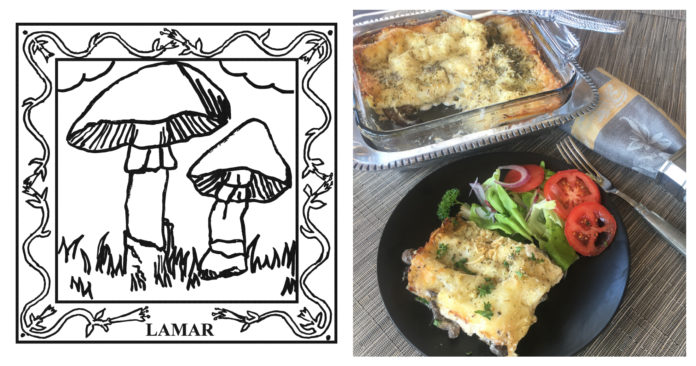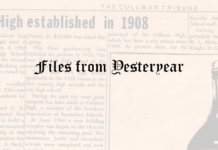
The Cullman Tribune is celebrating the Alabama Bicentennial (1819-2019) with statewide field reporting by Alabama Master Gardener/Botanical Artist Ben Johnson South. This year-long feature, “The 67-County Alabama Garden Party,” will spotlight different counties each week. Each county will get its own “quilt block,” along with a historical profile, and we’ll share a recipe specific to the area. At the end of the year, all 67 counties will be put in a book to commemorate the Bicentennial.
Lamar County
At some delightful perch on this Garden Party tour across Alabama, I knew we would want to eat and explore native-grown mushrooms. Deeply forested Lamar County is a natural place for this adventure.
For centuries, present day Lamar County was Chickasaw territory. The Chickasaws foraged wild mushrooms for food, medicine and religious practices.
Mushrooms sprout from decaying woodland matter such as fallen branches, logs, tree roots and leaf debris. The tree-studded Fall Line hills here in northwest Alabama provide an ideal growing environment for mushrooms as the terrain slopes down to sandy, clay-rich flatlands.
Lamar County was established in February 1877. The county was named for a United States senator from Mississippi with the magnificent moniker, Lucius Quintus Cincinnatus Lamar.
Due in part to America’s growing appetite for organic foods, the interest in mushrooms has, well, mushroomed in recent years. But, from the early days of European settlers in Alabama, mushrooms have been treasured by the finest cooks.
Alabama is a state of massive biodiversity. Edible and non-edible mushrooms can be found in each of the state’s 67 counties.
Some mushrooms look and taste great but can kill you. To make sure we kept the best of ‘em and avoided the rest of ‘em, I chatted with Anthoni Goodman, founder and president of the Alabama Mushroom Society. Anthoni is a Ph.D. candidate in neuroscience at the University of Alabama at Birmingham.
WHAT ARE THE TOP FIVE MUSHROOMS ALABAMIANS SHOULD FORAGE AND EAT? “I would say the easiest to identify and reasonably easy to find mushrooms in the state are: 1. Chanterelles and Black Trumpets (Cantharellus and Craterellus species), 2. Chicken of the Woods (Laetiporus species), 3. Oyster Mushrooms (Pleurotus species), 4. Lion’s Mane (Hericeum species) and 5. Hen of the Woods (Grifola frondosa), though there are many others. We have a continually growing list of these on our website. Go to www.alabamamushroomsociety.org, then search: common-edible-mushrooms.”
WHAT DO YOU WANT ALABAMIANS TO KNOW ABOUT MUSHROOMS TO IGNITE THEIR ENTHUSIASM FOR THESE FUNGI? “There’s an entire kingdom hidden from us, lurking just beneath the forest floor that claims titles such as the largest organism on the planet, a kingdom that precedes land-dwelling animals and towered into the skies before there were trees!!! (Note: The triple exclamation points are mine but this “fun guy” is passionate about fungi.) The kingdom fungi literally connects all of the plants around us, trading nutrients and water, and even hunting and trapping nematodes. Yet we only see these strange creatures when they’re ready to germinate, and an odd fruit they make. Some are great for eating, some are good for kicking, and some contain toxins that will make your head spin, or your organs fail. This fascinating world is just out of sight but plays a titanic role in our local ecology and has shaped world religions, fed many of us, and provided nutrients for our forests and pastures. Next time you’re in the woods (Note: Lamar County road trip?), kick over some leaves or pull back some dead bark. Those long white threads, that’s them, going about their business. When these plants are ready, they will create a fruitbody, the mushroom, which comes in too many forms to count and defines the organism. Pick it, photograph it, smell it, most of these species haven’t changed much since before the dinosaurs roamed the Earth, and we have THOUSANDS of different species just here in Alabama!!!”
ARE THERE ANY “MAGIC MUSHROOMS” IN ALABAMA WHERE PLANTS + PEOPLE COMING TOGETHER COULD CAUSE THE PEOPLE TO “TRIP OUT?” “Ha! Absolutely! Since I’m representing the nonprofit organization, Alabama Mushroom Society, I can’t condone the use of illegal substances. That being said, we do include these psychedelic fungi in our educational discussions about mushrooms in general. Our more common psilocybin (the active psychedelic ingredient)-containing mushrooms are of the Psilocybe and Panaeolus genera and really love growing in ungulate fields (cow, horse, donkey, and pig), either directly from or nearby the animal droppings, and almost all will bruise a bluish color upon handling or being damaged. Interestingly, we just hosted an expert on psilocybin-containing mushrooms (among many other fungi!) who gave two presentations and several forays for our members.”
ARE THERE POISONOUS MUSHROOMS IN ALABAMA? “Yes indeed, we have hosts of mushrooms that can cause anything from an upset stomach to a nasty death. But, you can safely touch even the most toxic mushrooms with no ill consequences. Don’t fear the fungi! But also—don’t eat anything unless you’re 100% confident in your identification and you know it’s a safe-to-eat mushroom.”
I explained to Mr. Goodman that in this Bicentennial series, The 67-County, Alabama Garden Party, I’d like to help some plant-centric people find revenue-producing opportunities with plants, especially in remote parts of the state like Lamar County.
WHAT ARE YOUR THOUGHTS ON GROWING MUSHROOMS COMMERCIALLY IN ALABAMA? (I UNDERSTAND A “START UP” WOULDN’T REQUIRE MUCH MONEY AND MUSHROOMS ARE FAIRLY EASY TO GROW.) “It really depends on the size of the operation and the types of mushrooms that someone wants to grow. Not all counties are going to have the demand for it, but several farmers in Alabama drive into the farmers’ markets in Birmingham to sell their cultivated fungi (primarily Shiitake, Oyster Mushrooms and Lion’s Manes). One of the members of our Society’s leadership actually runs a spawn lab that produces and sells inoculated materials for individual or commercial growing of mushrooms. For those interested in cultivating mushrooms, there are several species that are fairly easy to grow and many more that require some expertise.”
HOW WOULD YOU SUGGEST ALABAMIANS EXPLORE AN INTEREST IN MUSHROOMS? “It really depends on the level of interest someone has. To be frank, most folks are only interested in finding edible mushrooms or photographing some of the more fascinating structures that fungi can produce. Whereas some of us more dorky types get really excited about the taxonomy and ecological niches and have a blast documenting our finds and identifying everything we can! For those who want to see what it’s all about, I recommend just getting out and taking some nice, clear photographs, posting them on our Facebook page and letting someone help you identify it. We also have a list of some of the better publications you can purchase (or even get from a library) listed on our webpage. These books, along with our webpage, Facebook group, and society meetings can be a great place to gather skills and knowledge regarding our local fungi and meet others with a similar interest (there are more of us than you think!). So, get out there, bring a friend, and check out our ephemeral and beautiful mushrooms. You might just come home with a skillet full of dinner, or on a bad day—a lovely walk in the woods.”
While you’re out foraging Lamar County on your mushroom mission, here are other positive and pleasurable PLANTS + PEOPLE things to explore, including Laurie Johnson’s original recipe for Lamar County Mushroom Lasagna.
*LAMAR COUNTY FARMERS’ MARKET- J Circle Northeast at Vernon Park, Vernon, AL 35592; Tuesdays 4-6 p.m. and Saturdays 8-11 a.m.; opens June 1
*MILLPORT FARMERS’ MARKET- McAdams Street behind city hall, Millport, AL 35576; Thursdays 3:30-6:30 p.m., June 6-Aug. 9
*SAM R. MURPHY WILDLIFE MANAGEMENT AREA- Popular for hunting whitetail deer through the tall grasses and woodlands
*LAMAR COUNTY PLANT ADVICE/EDUCATION- Alabama Cooperative Extension System local office at 281 Columbus Ave., Vernon, AL 35592, 205-695-7139
*PLANTING AN IDEA- In each of the 67 counties in Alabama there is ZOOM videoconferencing technology at the local office of the Alabama Cooperative Extension System. The Lamar County office (or any location) could with no additional expense host a videoconference with a knowledgeable enthusiast from the Alabama Mushroom Society. This could be a FREE-to-attend, public-invited information session with Q&A for those interested in mushroom farming for fun and profit.
Y’ALL COME to Lamar County on your 67-County, Alabama Garden Party tour! Great things are mushrooming here!
THANK YOU to Anthoni Goodman, founder and president of the Alabama Mushroom Society for sharing his enthusiasm for mushrooms. Also, thank you to Laurie Johnson for her original recipe for Lamar County Mushroom Lasagna.
Lamar County Mushroom Lasagna (~ 6 servings)
Some of us love our “meatless Mondays” or even go meatless more often as we include extra vegetables in our diets. However, on cold fall or winter days we also love warm comfort food like the ever-favorite lasagna. This meatless lasagna features mushrooms in the place normally occupied by beef, and the marinara (red sauce) is replaced by a white sauce. The result is a creamy meatless meal, with its richness perfectly balanced by a fresh salad of Alabama greens.
Ingredients:
- 2 – 3 lbs. assorted sliced mushrooms (portabellas, baby bellas, white, or other)
- 2 tbsp. olive oil
- 1 carton of ricotta cheese – can use lower fat version
- 2 eggs, lightly beaten
- 1 cup grated parmesan cheese
- 2 tbsp. minced fresh or dried parsley, plus more for serving, plus other minced fresh herbs such as basil and thyme or a little dried Italian seasoning mixture
- 2 cups chopped fresh spinach leaves (optional)
- 3 cups shredded mozzarella cheese – can use lower fat version
- ~ 2 cups white béchamel sauce or short cut and use 1 jar of prepared alfredo sauce
- 1 package oven-ready lasagna noodles or regular ones that have been boiled as directed
- Cooking spray
Instructions:
- Pre-heat oven to 350F.
- Sauté mushrooms until tender in olive oil and then drain residual oil and moisture from them.
- Mix ricotta cheese, 2 beaten eggs, the chopped spinach if using, parmesan cheese, parsley and other herbs or a little Italian seasoning in a mixing bowl.
- Assemble the lasagna
- Spray an 8 x 8 inch casserole pan with cooking spray. Start by spreading a thin layer of the white sauce in the bottom. Top with 3 lasagna strips. Spread a thin layer of the ricotta/egg mixture and top with a layer of cooked mushrooms (about 1/3 of them) and sprinkle with a layer of shredded mozzarella. Repeat the layers (sauce, noodles, ricotta/egg, mushrooms and mozzarella) until pan is full and you’ve run out of ingredients. End with mozzarella on top and a sprinkle of herbs or Italian seasoning.
- It can be refrigerated if desired before baking, but you need to add some “covered” cooking time. It also freezes well. If frozen, thaw in the refrigerator overnight.
- Cover with foil and bake in the pre-heated oven for about 20 minutes. Remove the foil and bake for another 20 minutes until very hot through the middle and bubbly and golden around the edges. Remove and let rest for a few minutes before cutting.
- Serve with a sprinkle of parsley or herbs as desired. Enjoy with a fresh salad of Alabama greens.
Also, check out Alabama Bicentennial: 200 ways to save Alabama for the next 200 years.
Copyright 2019 Humble Roots, LLC. All Rights Reserved.
























